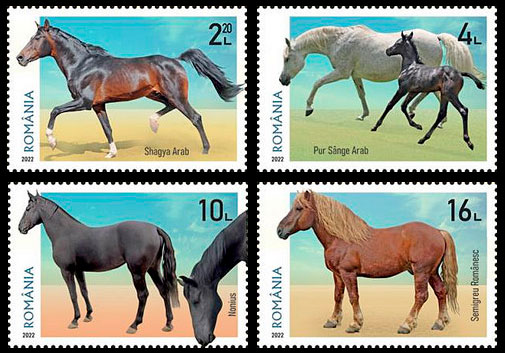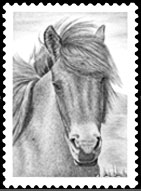
On August 9, 2022, the Romanian Post issued a series of postage stamps "Breeds of horses"
Lately, the Romanian Post has clearly favored horse lovers, and for the second year in a row, stamps dedicated to these beautiful animals have been issued. And if in 2021 the "Horses" series was of a general nature, this year the stamps will present specific breeds of horses. The stamps, created by designer George Ursachi, represent the beauty and pride of Romanian horse breeding: the Arab Shagia, the purebred Arabian horse, the Nonius and the Romanian light draft horse. The stamps were issued in mini sheets of 5 stamps plus one coupon.
Personally, I would like to see a slightly more realistic landscape in the background, but in general the series turned out to be beautiful: light and expressive. The artist perfectly conveyed the features of horses of different breeds, their strength, liveliness and grace. An additional charm of the series is given by a foal on a stamp with a purebred Arabian horse.
Arabian Shagya

The stamp with a face value of 2.20 lei depicts a horse of the Shagiya-Arab breed or simply Shagiya. These graceful horses are one of the varieties of the Arabian breed, bred in Austria-Hungary in the 19th century. At this time, the Austro-Hungarian Empire needed strong and hardy horses for the needs of the army. A number of plants were engaged in breeding a new breed: Babolna, Radautz and Piber (located on the territory of modern Hungary), a plant in Topolchanki (Slovakia), Mangalia (Romania) and Kabudzhik (Bulgaria).
The breed was named after the founding stallion Shagia. It was used for crossing with elite local mares of various breeds (Hungarian, Spanish and Arabian), which had a pronounced "oriental" type. The process of breeding a new breed was documented in unprecedented detail, experts noted the details of the origin of each of the foals, their colors, sizes, other characteristics, up to behavioral features. This set of documents is currently one of the most unique historical sources of the history of horse breeding in Europe.
Today, the Shaggia is a versatile horse that can be used both under saddle and lightly harnessed. Shagiya mostly have a gray suit, although there are other typical Arabic suits (red, brown). Outwardly, the Shagiya differ little from a typical Arab, however, in their constitution they are more massive (average height 150-162 cm at the withers), and the mane, bangs and tail are longer, thick, straight and silky.
Purebred Arabian horse

The 4 lei stamp depicts an Arabian horse with a foal. The Arabian thoroughbred breed is an ancient breed of riding horses, bred on the territory of the Arabian Peninsula as early as the 4th-7th centuries. The exterior of the Arabian horse is well known to everyone: a medium-sized animal, with a pronounced oriental breed. Small head, wide forehead, large expressive eyes and small ears. Everyone recognizes the characteristic concave profile and high, arched neck.
The playfulness and efficiency of the Arabs, fixed by countless generations of thoroughbred breeding, were actively used to form many modern breeds: thoroughbred riding, Trakehner, Lipizzan, Shagiya and many others. Arabian horses are rarely used in equestrian sports due to their small stature. But on the other hand, they actively participate in races at hippodromes. Firstly, this is a great way to test their working qualities, and secondly, a great spectacle for all horse lovers.
Nonius

Nonius, presented on a stamp with a face value of 10 lei. The Nonius is a Hungarian breed of draft horse. It was bred in the 19th century at the Mezohegyes stud farm. The ancestor of the breed was the Anglo-Norman stallion Nonius, born in 1818, who gave the name to this breed. Mares of different breeds were selected for him - Arabian, Spanish, Holstein, Lipizzan, Anglo-Norman, English half-breeds. By 1840, the offspring of Nonius had already become a breed - they were tall, massive horses that quickly spread throughout Austria-Hungary. Nonius is distinguished by a strong constitution, a muscular neck, a deep chest, short, powerful and dry legs. The head is rough, often hook-nosed (influence of Kladruby horses) with small eyes. The shoulders and back are muscular and strong. The suit is predominantly bay, caracal or black, less often - red.
Today, two types are distinguished in the breed: the first, larger and heavier (height at the withers 160-168 cm) is used in harness. The second, lighter (height at the withers 150-160 cm) works under the saddle. Nonius are valued for their friendly, calm nature, willingness to cooperate with a person and equally good work both in harness and under saddle. In addition, they are very hardy and unpretentious in content. Today verniers are most often used in agriculture and driving.
Romanian light draft horse

The Romanian light draft horse featured on the 16 lei stamp is a relatively new breed. In 1950, an important project began at the Bucharest Animal Research Institute to create a heavy horse breed adapted to the local climate and terrain. The country needed a strong and hardy horse, suitable for agricultural and transport work, including in mountainous areas. Initially, it was planned to cross thoroughbred English mares with Ardennes draft horses. But the English horses did not acclimatize well in Romania and were subsequently replaced by the Furioso Nord Star and Lippitsian mares. At first, the breeding of the new breed was carried out at the Rushetsu and Boncida stud farms, but then some of the horses were transported to the Beklin stud farm. After many years of painstaking work of several generations of specialists, a strong, strong and at the same time harmonious light heavy horse was created. The breed was officially registered in 1988.
Currently, two types of Romanian draft horse are distinguished: large heavy trucks are bred in Becklin, ideal for heavy work in the Transylvanian Highlands. These are horses 158-160 cm tall with short withers, well-developed musculature of the croup and massive, strong limbs. Draft horse from Becklin are unusually strong, they are able to pull loads up to 10 tons. In 1965 - 1988, the Rushetsu stud farm was engaged in breeding a lighter and more frisky horse for work on the plains. Horses of these breeds are still actively used in agriculture and forestry. They are strong, but harmonious and attractive, have a calm character, obedient and easy to train.
Перейти в каталог
I apologize for any errors or inaccuracies


